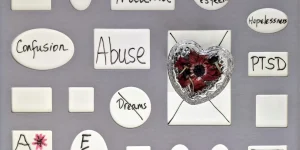What is my trauma response?
Category: Trauma
Trauma, whether it’s momentary or long term, affects people in different ways. This probably isn’t news to you.
But did you know four distinct responses can help explain how your experiences show up in your reactions and behavior?
First, there’s fight-or-flight, the one you’re probably most familiar with. In basic terms, when you encounter a threat, you either resist or retaliate, or simply flee.
Maybe you’ve also heard this called fight, flight, or freeze. You can think of the freeze response as something akin to stalling, a temporary pause that gives your mind and body a chance to plan and prepare for your next steps.
But your response to trauma can go beyond fight, flight, or freeze.
The fawn response, a term coined by therapist Pete Walker, describes (often unconscious) behavior that aims to please, appease, and pacify the threat in an effort to keep yourself safe from further harm.
We’ll explain these four trauma responses in depth below, plus offer some background on why they show up and guidance on recognizing (and navigating) your own response.

Topic Of Discussion
What is a trauma response?
A trauma response is the reflexive use of over-adaptive coping mechanisms in the real or perceived presence of a trauma event. The four trauma responses most commonly recognized are fight, flight, freeze, fawn, sometimes called the 4 Fs of trauma.
When we experience something traumatic or have been exposed to prolonged stress, it causes part of our brain, the amygdala, to go into hyperdrive where we see and feel threats in nonthreatening situations. This causes us to act in ways that we don’t understand and can leave us feeling like we no longer have control over ourselves. The response is often based on what your brain thinks will help you survive the current situation.
In a study about the effects of psychological trauma, researchers note our bodies are designed to respond to perceived threats through a constellation of near-instantaneous, reflexive survival behaviors. Via a short-term strategy, chemicals are sent into our bloodstream to activate the sympathetic nervous system’s defenses.
But when stress responses are constantly triggered, there’s not enough time to metabolize the chemicals, and our nervous system overloads and dysregulates—putting us squarely in the survival zone. The temporary defenses become sustained as our body shifts into a state of sympathetic nervous system dominance.
Notably, these trauma responses aren’t exclusive to people who’ve experienced those big “T” events (such as war, death, or disaster) commonly linked to meaningful trauma. The reality is that trauma exists across a continuum of stress.
Little “T” events, sometimes called micro-traumas, can also be profoundly affecting since trauma is a subjective and individualized experience. For example, some traumatic stressors can include events such as a bad breakup, a betrayal of trust, a chronically abusive workplace, or undergoing something subtly frightening over a period of time. They may not feel particularly injurious, but the complex effects of trauma can still affect you significantly when it’s not emotionally processed and integrated—somatically, spiritually, and mentally.
If it’s not resolved, trauma can essentially convert into stuck, frozen energy that your body will uniquely respond to physiologically in the form of a trauma response.
Now, here’s a closer look at the four main reactions.
The Fight Response
This response tends to stem from the unconscious belief that maintaining power and control over others will lead to the acceptance, love, and safety you need but didn’t get in childhood.
This response tends to show up more commonly when your caregivers:
- didn’t provide reasonable and healthy limits
- gave you whatever you asked for
- shamed you
- demonstrated narcissistic rage, bullying, or disgust
While fight often refers to actual physical or verbal aggression, it can encompass any action you take to stand up to a threat or negate it, like:
- making a public social media post after your partner cheats to let everyone know what they did
- shouting at your friend when they accidentally mention something you wanted to keep private
- spreading a rumor about a co-worker who criticized your work
- refusing to speak with your partner for a week when they lose your favorite sunglasses
If you notice yourself exhibiting the above behaviors, take a moment to slow down and think about how you are positioning yourself at the moment. It may feel good to access your physicality to gain mobility in the situation and have your insides reflect your outsides, but it comes at the cost of connection and others feeling secure around you.
In order to release this, you can use deep breathing, warm baths or showers, routines, mindfulness, and being gentle with yourself.
The fight response preps you to be physical, so you can also lean into exercise to allow the body to calm and achieve homeostasis. By practicing mindfulness and a burst of constructive activity like yoga or stretching, it activates your parasympathetic system. It releases anxiety and helps you sink back into the immediate environment so you feel safe to reconnect.
The Flight Response
A flight response, in short, is characterized by the desire to escape or deny pain, emotional turmoil, and other distress.
You might find yourself trapped in flight mode if, as a child, escaping your parents helped you dodge most of their unkindness and ease the impact of the abuse you experienced.
Escape might take a literal form:
- staying longer hours at school and friends’ houses
- wandering the neighborhood
Or a more figurative one:
- throwing yourself into your studies to occupy yourself
- creating endless plans for escape
- drowning out arguments with music
As an adult, you might continue to flee challenging or difficult situations by:
- working toward perfection in all aspects of life so no one can criticize or challenge you
- ending relationships when you feel threatened, before the other person can break up with you
- avoiding conflict, or any situation that brings up difficult or painful emotions
- using work, hobbies, or even alcohol and substances to fend off feelings of fear, anxiety, or panic
To drop back into yourself, do things that create an immediate, visceral reaction with your body. Pay attention to any tense muscles and relax them to relax the mind. Try to do some bodywork and intentional movements to halt the stress response so you can think about how you want to respond instead of your initial impulse to react.
Utilizing coping techniques that are tactile and grounding, like drinking a warm beverage or eating crunchy food can be helpful. The building connections with those around you, which increases feel-good, happy chemicals like endorphins and serotonin is also encouraged.
The Freeze Response
The freeze response serves as a stalling tactic. You brain presses the “pause” button but remains hypervigilant, waiting and watching carefully until it can determine whether fleeing or fighting offers a better route to safety.
Some experts have pointed out this response actually takes place first, before you decide to flee or fight. And when either action seems less than feasible? You might then “flop” in response to your fright.
A long-term freeze response can come to resemble a mask you use to protect yourself when you can’t identify any means of fighting back or escaping.
Behind the mask, you might:
- use fantasy or imagination to escape day-to-day distress
- prefer solitude and avoid close relationships
- hide emotions and feelings
- physically detach from the world through sleep, or by staying in your room or house
- mentally “check out” from situations that feel painful or stressful
To counteract that loss of connection with yourself, therapists recommend doing grounding exercises if you catch yourself starting to dissociate.
One exercise we can do is scan around our immediate surroundings for a red (or color of your choice) object. For me at the moment, I see my red shirt. Then what I’ll do is focus my eyes on it, say red hoodie, and take one deep, slow breath. Then I’ll scan the room for a second red item and do the same.
Repeat this five times. Doing this can help bring us back to our present moment and the environment we are currently in versus the environment we create when we’re in a trauma response that’s taking us out of the present moment.
The Fawn Response
This response, which termed “fawning,” offers an alternate path to safety. You escape harm, in short, by learning to please the person threatening you and keep them happy.
In childhood, this might involve:
- ignoring your own needs to take care of a parent
- making yourself as useful and helpful as possible
- neglecting or failing to develop your own self-identity
- offering praise and admiration, even when they criticize you
You might learn to fawn, for example, to please a narcissistically defended parent, or one whose behavior you couldn’t predict.
Giving up your personal boundaries and limits in childhood may have helped minimize abuse, but this response tends to linger into adulthood, where it often drives codependency or people-pleasing tendencies.
You might:
- agree to whatever your partner asks of you, even if you’d rather not
- constantly praise a manager in hope of avoiding criticism or negative feedback
- feel as if you know very little about what you like or enjoy
- avoid sharing your own thoughts or feelings in close relationships for fear of making others angry
- have few, if any, boundaries around your own needs
If you’re noticing that you’re fawning often, be extra compassionate with yourself as you begin to separate what feelings belong to you and what belongs to other people. Observe yourself when you’re around others to add in buffering time to help prevent resorting to fawning. The first step is awareness and learning how to start putting up boundaries to take up space.
Next Steps
Both “big” and “little” traumas can cause us to have trauma responses. These responses typically fall in the categories of fight, flight, freeze and fawn.
Some of the best ways to manage these responses is by practicing coping skills, such as grounding and mindfulness, that make us aware of our bodies and environment.
If you or a loved one is experiencing fight, flight, freeze and fawn responses, and the responses and trauma is impacting your daily life, consider speaking with a therapist or counselor.
Tri-Star Counseling, LLC provides therapy services to people in Johnson City, Bristol and Kingsport, Tennessee and throughout the rest of the Tri-Cities area. We also offer telehealth services to Tennessee residents all over the state. If you are struggling with trauma related concerns, please feel free to schedule an appointment with us. It would be our privilege to walk with you on your healing journey.
Identify Your Trauma Learn Methods to Help Heal Start Your Healing Journey Today!
The UNSTUCK workbook is designed to help you move beyond trauma by answering key questions like, Can you get stuck at the age your trauma happened? Through guided exercises, you’ll explore different types of trauma and break free from patterns holding you back. Take the next step in your healing journey today!



